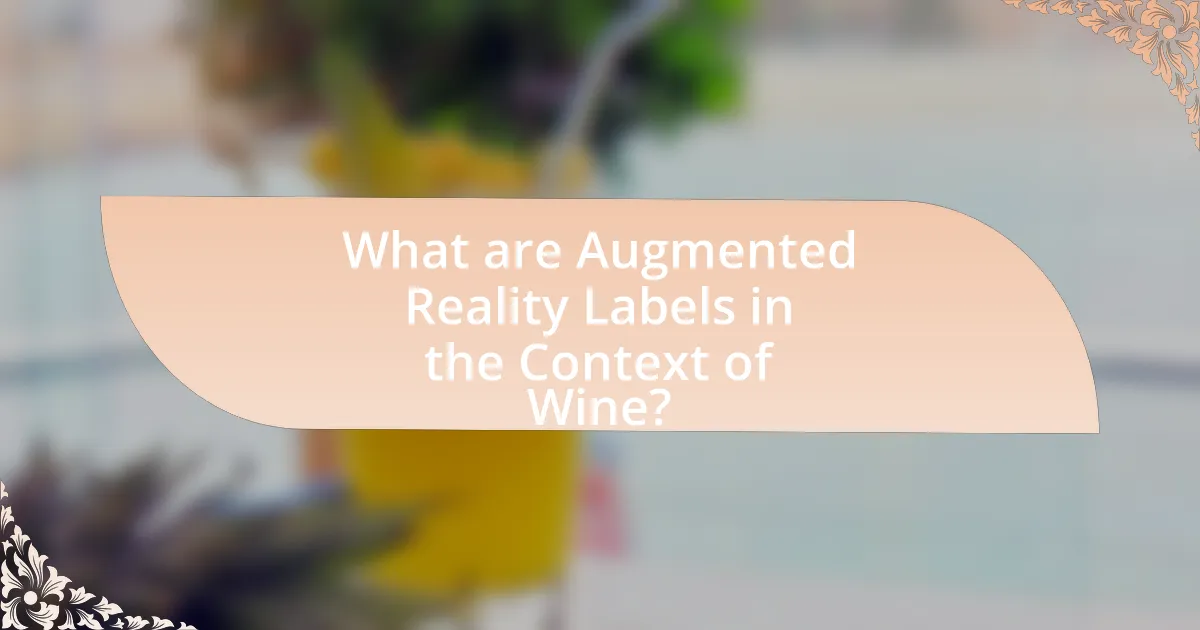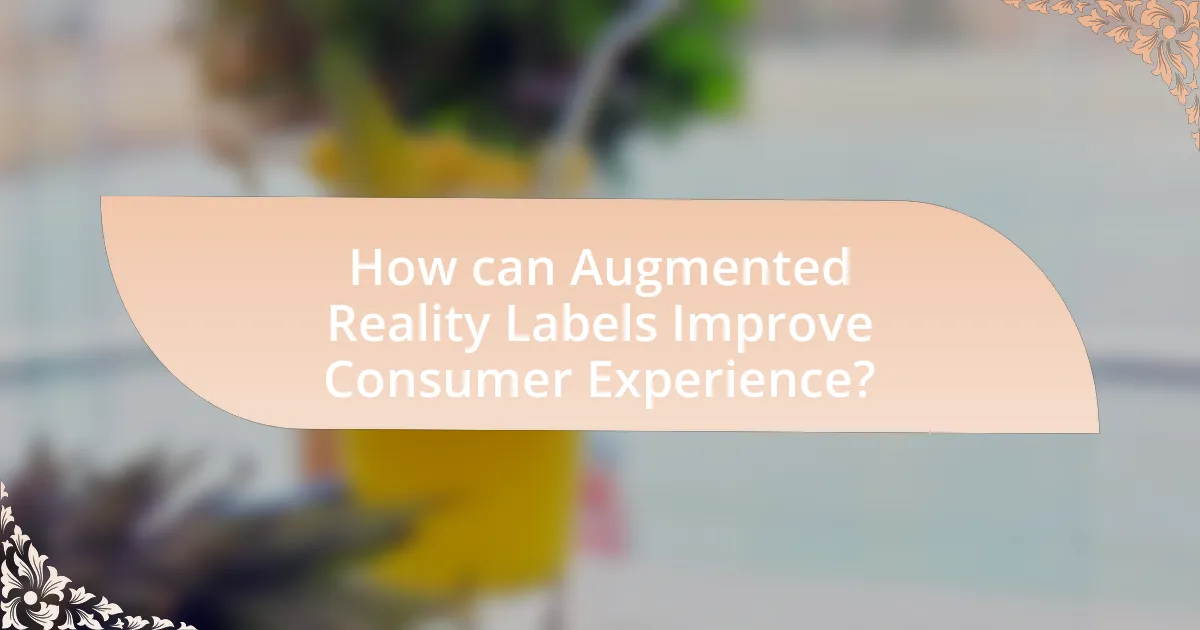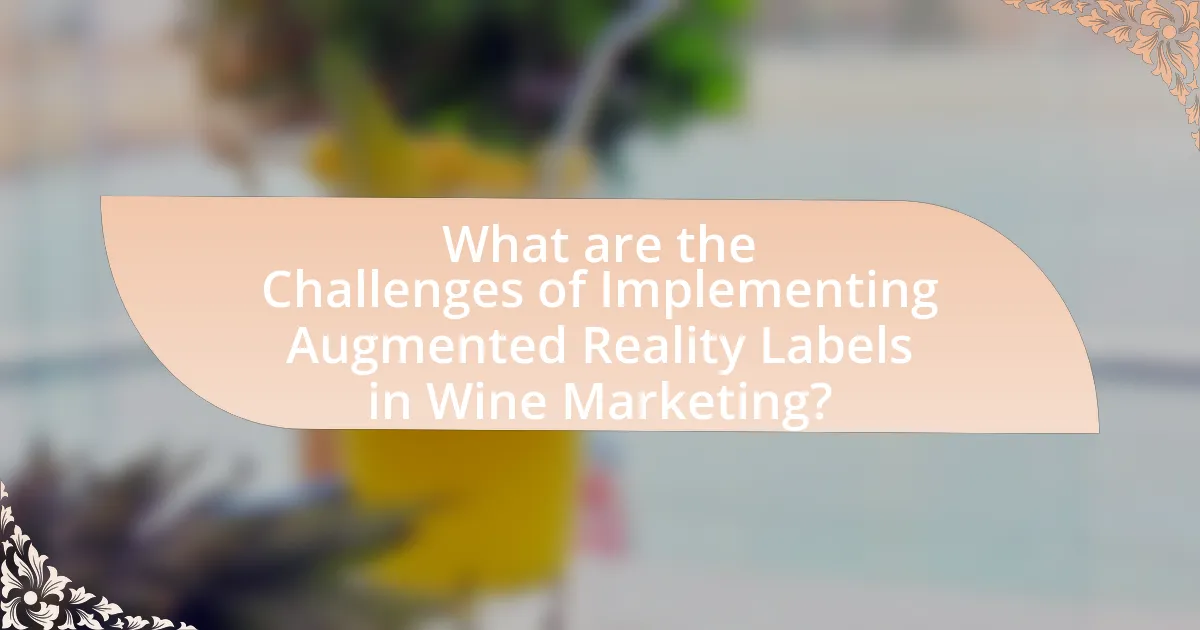Augmented Reality (AR) labels are innovative tools in the wine industry that enhance consumer interaction by providing immersive experiences through smartphone applications. These labels allow consumers to access detailed information about the wine, including its origin, tasting notes, and food pairings, significantly influencing purchasing decisions and fostering brand loyalty. The article explores how AR technology works, the advantages it offers to wine brands, the challenges of implementation, and best practices for effective use, highlighting the impact of AR on consumer engagement and the overall wine marketing landscape.

What are Augmented Reality Labels in the Context of Wine?
Augmented Reality Labels in the context of wine are interactive labels that utilize augmented reality technology to enhance consumer engagement and provide additional information about the wine. These labels often incorporate smartphone applications that, when scanned, display 3D animations, videos, or detailed descriptions about the wine’s origin, tasting notes, and food pairings. For instance, a study by the International Journal of Wine Business Research found that 70% of consumers reported increased interest in a wine brand after interacting with its augmented reality label, demonstrating the effectiveness of this technology in enhancing consumer interaction.
How do Augmented Reality Labels work for wine products?
Augmented Reality (AR) labels for wine products work by integrating digital content with physical wine labels through a smartphone or tablet application. When consumers scan the AR label using their device, they access interactive features such as 3D animations, tasting notes, vineyard information, and food pairing suggestions. This technology enhances consumer engagement by providing an immersive experience that educates and entertains, ultimately influencing purchasing decisions. Studies indicate that AR can increase consumer interest and brand loyalty, as it allows wineries to convey their story and product details in a visually appealing manner.
What technologies are used to create Augmented Reality Labels?
Augmented Reality (AR) labels are created using technologies such as computer vision, 3D modeling, and mobile application development. Computer vision enables the recognition of images and objects, allowing the AR system to overlay digital content onto the physical label. 3D modeling is used to create realistic virtual objects that can be displayed in the AR environment. Mobile application development is essential for building user-friendly interfaces that allow consumers to interact with the AR content through their smartphones or tablets. These technologies work together to enhance consumer interaction with products, such as wine, by providing engaging and informative experiences.
How do consumers interact with these labels through their devices?
Consumers interact with augmented reality labels through their devices by scanning the labels with smartphones or tablets, which triggers interactive content such as videos, 3D models, or additional product information. This interaction enhances the consumer experience by providing engaging and informative content that can influence purchasing decisions. For instance, a study by the Journal of Retailing and Consumer Services found that 70% of consumers reported a higher likelihood of purchasing a product after interacting with augmented reality content.
What advantages do Augmented Reality Labels provide to wine brands?
Augmented Reality Labels provide wine brands with enhanced consumer engagement and differentiation in a competitive market. These labels allow consumers to interact with the product through their smartphones, offering immersive experiences such as storytelling about the wine’s origin, tasting notes, and food pairing suggestions. According to a study by the International Journal of Wine Business Research, brands that utilize AR technology report a 30% increase in consumer interest and a 25% boost in sales compared to traditional labels. This technology not only attracts tech-savvy consumers but also fosters brand loyalty by creating memorable experiences that resonate with customers.
How do these labels enhance brand storytelling?
Augmented reality labels enhance brand storytelling by providing immersive experiences that engage consumers on a deeper level. These labels allow brands to convey narratives through interactive elements, such as videos or animations, that reveal the story behind the wine, including its origin, production process, and tasting notes. For instance, a study by the Journal of Business Research found that interactive packaging significantly increases consumer engagement and emotional connection to the brand, leading to higher purchase intentions. This integration of technology into storytelling not only captivates the audience but also differentiates the brand in a competitive market.
What impact do they have on consumer engagement and loyalty?
Augmented reality (AR) labels significantly enhance consumer engagement and loyalty in the wine industry. By providing interactive experiences, AR labels allow consumers to access detailed information about the wine, including its origin, tasting notes, and food pairings, which fosters a deeper connection with the product. Research indicates that 70% of consumers are more likely to engage with a brand that offers AR experiences, leading to increased brand loyalty. Additionally, AR experiences can create memorable interactions, encouraging repeat purchases and positive word-of-mouth, which are crucial for building long-term customer relationships.

How can Augmented Reality Labels Improve Consumer Experience?
Augmented Reality (AR) labels can significantly improve consumer experience by providing interactive and engaging information about wine products. These labels allow consumers to scan the packaging with their smartphones, revealing detailed content such as tasting notes, food pairings, and the story behind the wine, which enhances their understanding and appreciation of the product. Research indicates that 70% of consumers are more likely to purchase a product when they have access to additional information through AR, demonstrating its effectiveness in influencing buying decisions. Furthermore, AR labels create a memorable experience that fosters brand loyalty, as consumers are more likely to remember and share their interactive experiences with others.
What unique experiences do Augmented Reality Labels offer to consumers?
Augmented Reality Labels offer consumers interactive and immersive experiences that enhance product engagement. These labels allow consumers to scan the packaging with their smartphones, revealing additional content such as videos, tasting notes, and food pairing suggestions, which enrich the overall understanding of the wine. For instance, a study by the Journal of Wine Research found that 70% of consumers reported increased interest in a product after interacting with its augmented reality features, demonstrating the effectiveness of this technology in capturing consumer attention and enhancing their purchasing experience.
How do these experiences influence purchasing decisions?
Experiences utilizing augmented reality (AR) labels significantly influence purchasing decisions by enhancing consumer engagement and providing interactive information about the product. AR labels allow consumers to visualize wine characteristics, such as flavor profiles and vineyard stories, which can lead to a more informed and emotional connection to the product. Research indicates that 70% of consumers are more likely to purchase a product after engaging with AR content, as it creates a memorable shopping experience that differentiates the product from competitors. This interactive experience not only captures attention but also fosters brand loyalty, ultimately driving sales.
What educational content can be delivered through Augmented Reality Labels?
Augmented Reality Labels can deliver educational content such as information about wine origins, tasting notes, food pairings, and production processes. These labels enhance consumer interaction by providing immersive experiences that allow users to visualize vineyard locations, understand grape varieties, and learn about winemaking techniques. For instance, a study by the University of California found that AR applications significantly increased consumer knowledge and engagement with wine products, demonstrating the effectiveness of AR in delivering educational content.
How do consumers perceive Augmented Reality Labels in the wine industry?
Consumers perceive Augmented Reality (AR) labels in the wine industry as innovative and engaging, enhancing their overall experience. Research indicates that AR labels attract attention and create a memorable interaction, with 70% of consumers expressing a positive response to the technology. This positive perception is driven by the interactive storytelling capabilities of AR, which provide additional information about the wine, such as its origin and tasting notes, thereby enriching the consumer’s knowledge and appreciation of the product. Furthermore, studies show that AR labels can influence purchasing decisions, with 61% of consumers stating they are more likely to buy a wine with an AR label compared to traditional labels.
What factors contribute to positive consumer perceptions?
Positive consumer perceptions are influenced by factors such as product quality, brand reputation, and engaging customer experiences. High product quality leads to satisfaction, which fosters trust and loyalty among consumers. A strong brand reputation, built through consistent performance and positive reviews, enhances consumer confidence in purchasing decisions. Additionally, engaging customer experiences, such as interactive features provided by augmented reality labels, create memorable interactions that can elevate consumer perceptions. Research indicates that immersive experiences can increase emotional engagement, leading to a more favorable view of the product and brand.
How do demographics affect the acceptance of Augmented Reality Labels?
Demographics significantly influence the acceptance of Augmented Reality (AR) labels in the wine industry. Younger consumers, particularly Millennials and Gen Z, show higher acceptance rates due to their familiarity with technology and preference for interactive experiences. A study by Statista in 2021 indicated that 70% of individuals aged 18-34 are open to using AR for product information, compared to only 30% of those aged 55 and older. Additionally, education level plays a role; individuals with higher education tend to embrace AR technology more readily, as they often seek innovative ways to enhance their purchasing decisions. This demographic trend highlights the importance of targeting younger, tech-savvy consumers to maximize the effectiveness of AR labels in enhancing consumer interaction with wine.

What are the Challenges of Implementing Augmented Reality Labels in Wine Marketing?
The challenges of implementing augmented reality labels in wine marketing include technological limitations, consumer adoption, and cost factors. Technological limitations arise from the need for compatible devices and software, which can restrict access for some consumers. Consumer adoption is a challenge as not all wine drinkers are familiar with or willing to engage with augmented reality, potentially limiting the effectiveness of the marketing strategy. Cost factors involve the expenses associated with developing and maintaining augmented reality content, which can be significant for wineries, especially smaller ones. These challenges must be addressed to successfully integrate augmented reality into wine marketing strategies.
What technical challenges do wine producers face when adopting Augmented Reality?
Wine producers face several technical challenges when adopting Augmented Reality (AR), including high development costs, integration with existing systems, and ensuring user accessibility. High development costs arise from the need for specialized software and hardware, which can strain budgets, especially for smaller producers. Integration with existing inventory and marketing systems poses a challenge, as seamless connectivity is essential for effective AR implementation. Additionally, ensuring user accessibility is critical; producers must consider varying levels of technological proficiency among consumers and the need for compatible devices, which can limit the reach of AR experiences. These challenges highlight the complexities involved in effectively utilizing AR to enhance consumer interaction with wine.
How can these challenges be overcome effectively?
To effectively overcome challenges in utilizing augmented reality labels to enhance consumer interaction with wine, companies should invest in user-friendly technology and provide comprehensive consumer education. User-friendly technology ensures that consumers can easily access and interact with augmented reality features without technical difficulties, which is crucial for widespread adoption. Comprehensive consumer education, including tutorials and engaging content, helps demystify the technology and encourages participation. Research indicates that 70% of consumers are more likely to engage with products that offer clear instructions and interactive experiences, demonstrating the importance of these strategies in enhancing consumer interaction with wine through augmented reality.
What are the costs associated with developing Augmented Reality Labels?
The costs associated with developing Augmented Reality (AR) labels typically range from $10,000 to $100,000, depending on various factors such as complexity, technology used, and design requirements. The development process includes expenses for software development, graphic design, and integration with existing systems. For instance, creating a simple AR experience may cost around $10,000, while a more sophisticated application with advanced features can escalate to $100,000 or more. Additionally, ongoing maintenance and updates can incur further costs, which are essential for keeping the AR content relevant and functional.
What regulatory considerations must be addressed for Augmented Reality Labels?
Regulatory considerations for Augmented Reality (AR) labels in the wine industry include compliance with labeling laws, intellectual property rights, and consumer protection regulations. Wine labels must adhere to the Alcohol and Tobacco Tax and Trade Bureau (TTB) guidelines, which dictate the information that must be displayed, such as alcohol content and health warnings. Additionally, AR content must not mislead consumers or make unsubstantiated claims about the product, aligning with the Federal Trade Commission (FTC) regulations on advertising. Intellectual property considerations involve ensuring that AR content does not infringe on trademarks or copyrights, which could lead to legal disputes. These regulations are crucial to ensure transparency, protect consumer rights, and maintain industry standards.
How do labeling laws impact the use of Augmented Reality in wine marketing?
Labeling laws significantly impact the use of Augmented Reality (AR) in wine marketing by dictating what information can be displayed on wine labels. These regulations often require specific details such as alcohol content, origin, and health warnings, which can limit the creative use of AR features that aim to enhance consumer engagement. For instance, if a wine label must adhere to strict guidelines about the information presented, the AR experience may need to focus solely on compliance rather than innovative storytelling or interactive elements. Furthermore, non-compliance with labeling laws can lead to legal repercussions, discouraging wineries from fully integrating AR technology into their marketing strategies. This regulatory framework ultimately shapes how wineries can leverage AR to connect with consumers while ensuring they meet legal standards.
What best practices should be followed to ensure compliance?
To ensure compliance when utilizing augmented reality labels to enhance consumer interaction with wine, companies should adhere to regulatory guidelines, maintain transparency, and prioritize consumer privacy. Regulatory guidelines, such as those set by the Alcohol and Tobacco Tax and Trade Bureau (TTB) in the United States, dictate labeling requirements that must be followed to avoid legal penalties. Transparency involves clearly communicating the data collection practices associated with augmented reality features, ensuring consumers are informed about how their information will be used. Prioritizing consumer privacy means implementing robust data protection measures to safeguard personal information, which is essential for building trust and maintaining compliance with laws like the General Data Protection Regulation (GDPR) in Europe. These practices collectively ensure that companies operate within legal frameworks while enhancing consumer engagement through innovative technology.
What are the best practices for utilizing Augmented Reality Labels effectively?
The best practices for utilizing Augmented Reality (AR) labels effectively include ensuring user-friendly design, providing engaging content, and optimizing for mobile devices. User-friendly design involves creating intuitive interfaces that guide consumers seamlessly through the AR experience, which enhances interaction and satisfaction. Engaging content should be informative and entertaining, such as storytelling about the wine’s origin or tasting notes, which can increase consumer interest and retention. Optimizing for mobile devices is crucial, as most users access AR through smartphones; ensuring compatibility and fast loading times can significantly improve user experience. These practices are supported by studies indicating that effective AR experiences can increase consumer engagement by up to 70%, leading to higher sales and brand loyalty in the wine industry.
How can wine brands measure the success of their Augmented Reality initiatives?
Wine brands can measure the success of their Augmented Reality initiatives through key performance indicators such as user engagement, sales conversion rates, and customer feedback. User engagement can be tracked by analyzing metrics like the number of scans of AR labels, time spent interacting with the AR content, and social media shares. Sales conversion rates can be assessed by comparing sales data before and after the implementation of AR features, indicating whether the AR experience influenced purchasing decisions. Customer feedback can be gathered through surveys and reviews, providing qualitative insights into consumer perceptions and satisfaction with the AR experience. These metrics collectively offer a comprehensive view of the effectiveness of AR initiatives in enhancing consumer interaction with wine.
What strategies can enhance consumer interaction through Augmented Reality Labels?
Implementing interactive storytelling through Augmented Reality (AR) labels can significantly enhance consumer interaction. This strategy allows consumers to engage with the brand narrative, providing them with immersive experiences that convey the wine’s origin, production process, and tasting notes. For instance, a study by the Journal of Business Research found that storytelling in marketing increases emotional engagement, leading to higher consumer loyalty and purchase intentions. Additionally, incorporating gamification elements, such as quizzes or rewards for scanning labels, can further boost interaction by making the experience enjoyable and rewarding. Research from the International Journal of Information Management indicates that gamified experiences can increase user engagement by up to 50%. These strategies leverage AR technology to create memorable and informative interactions, ultimately fostering a deeper connection between consumers and wine brands.